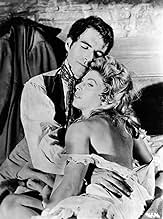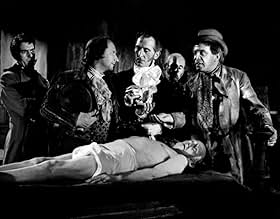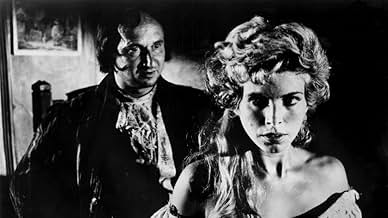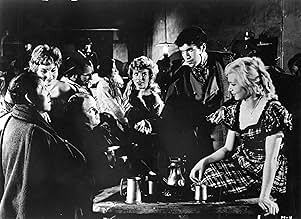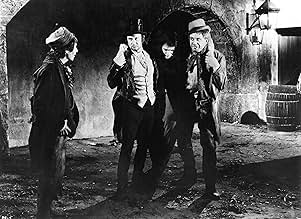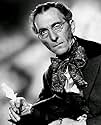The Flesh and the Fiends
- 1960
- 1h 34min
CALIFICACIÓN DE IMDb
6.9/10
2.5 k
TU CALIFICACIÓN
Agrega una trama en tu idiomaIn 1828 Scotland, Edinburgh surgeon Dr. Knox does medical research on cadavers he buys from murderers Burke and Hare, without questioning the unethical procurement methods.In 1828 Scotland, Edinburgh surgeon Dr. Knox does medical research on cadavers he buys from murderers Burke and Hare, without questioning the unethical procurement methods.In 1828 Scotland, Edinburgh surgeon Dr. Knox does medical research on cadavers he buys from murderers Burke and Hare, without questioning the unethical procurement methods.
- Dirección
- Guionistas
- Elenco
Beckett Bould
- Old Angus
- (as Becket Bould)
Opiniones destacadas
Now that this film has been restored for DVD by Image Entertainment, it is a joy to watch -- nice but not flashy photography and directing, and masterful but not overbearing acting make this a good find. But it's not quite as satisfying as "The Body Snatcher" on the same Burke/Hare theme because it doesn't engage the dark undertones of the human psyche through its sadistic "graverobbers" as much as the Karloff film, but instead dwells more on the scientific ethics issues. Still, some sick, slightly scary scenes with Pleasence. Cushing is excellent as always. If you saw this on video or TV, you might want to give it a second look (like I did) on DVD because it looks a whole lot better.
I'll leave it up to others to debate whether 'Mania' (a.k.a. 'The Flesh and the Fiends') is technically a horror movie. While dealing with horrific events, and told in a fashion with plenty of creepy moments, I would still say it isn't horror myself. Whatever you classify it as it is a seriously underrated thriller with strong performances from an above average cast. Director John Gilling went on to make the Hammer classic 'The Plague Of Zombies' later in the 1960s, and stars Peter Cushing ('Twins Of Evil') and Donald Pleasence ('Halloween') both made a strong impact on the horror genre, so fans will be interested to see this for those reasons alone. Cushing is excellent as the stubborn and driven Dr. Knox who needs a steady supply of corpses to dissect, and Pleasence plays the slimy William Hare, who along with his equally creepy colleague William Burke (George Rose), gleefully fills that need. The only problem is that Burke and Hare have no qualms about where the corpses come from, or whether they need a little "help" along the way. Burke and Hare were real body snatchers, but I have no idea just how historically accurate the events depicted in this movie are. But it certainly is entertaining and worth watching for the terrific performances by Cushing, Pleasence and Rose, and also for Billie Whitelaw ('The Omen') who has a small but important supporting role as the love interest for one of Dr. Knox's medical students (John Cairney - 'Jason And The Argonauts').
THE FLESH AND THE FIENDS followed in the wake of the success of Hammer Films' early successes. Although not actually a Hammer Film Production, it shares many stylistic points with Hammer. However, the script is a largely accurate version of the history of the body snatchers, Burke and Hare, and their main customer, Dr. Robert Knox.
Although there are memorable performances in this film, it is Peter Cushing's work as Dr. Knox that ultimately stands out. During the 1820's in Edinburgh, Scotland, Dr. Knox illegally bought cadavers from Burke and Hare. In spite of every reason to be suspicious of Burke and Hare, Dr. Know persisted in obtaining cadavers from them for medical lectures. To Dr. Knox, the training of competent doctors took precedent over ethical considerations.
In a remarkable scene in the denouement, a little girl in the street begs alms from Dr. Knox. Cushing tells her that he doesn't have any money with him, but if she will step over to his house he will give her some. The little girl politely declines the offer, saying, "Oh, no, you might be Dr. Knox." Cushing's unspoken response is truly unforgettable. It makes you realize that Peter Cushing was really a fine actor. What a pity his talent was too often wasted in pictures that were beneath him.
Although there are memorable performances in this film, it is Peter Cushing's work as Dr. Knox that ultimately stands out. During the 1820's in Edinburgh, Scotland, Dr. Knox illegally bought cadavers from Burke and Hare. In spite of every reason to be suspicious of Burke and Hare, Dr. Know persisted in obtaining cadavers from them for medical lectures. To Dr. Knox, the training of competent doctors took precedent over ethical considerations.
In a remarkable scene in the denouement, a little girl in the street begs alms from Dr. Knox. Cushing tells her that he doesn't have any money with him, but if she will step over to his house he will give her some. The little girl politely declines the offer, saying, "Oh, no, you might be Dr. Knox." Cushing's unspoken response is truly unforgettable. It makes you realize that Peter Cushing was really a fine actor. What a pity his talent was too often wasted in pictures that were beneath him.
Solid, well-crafted but rather patchy cinematic treatment of the saga of notorious 19th Century "Resurrectionists" Burke and Hare and their unorthodox employer Dr. Robert Knox; in the vein of Hammer horror (featuring two of their most notable participants in Cushing and Gilling) though the lack of color makes it seem a half-hearted attempt (even if, with an eye on the low-budget, it was probably a conscious choice by the film-makers as the intentions were clearly of a serious undertaking)!
Anyway, the best thing about the film - apart from the vivid recreation of the era - are the performances of Peter Cushing (as the cold Dr. Knox, not unlike Baron Frankenstein), Donald Pleasance (an impressive early performance as the oily but quick-thinking Hare - his come-uppance is especially eerie) and Billie Whitelaw (as the proverbial "tart with a heart of gold" who ends up as one of the victims); Burke is played as a scurrilous but jovial brute (but who murders with the apparent complicity of his own wife) by character actor George Rose. Dr. Knox's condescending attitude towards his fellow colleagues also provides a number of entertaining confrontation scenes (my favorite line is during their face-off at his house, when he brusquely terminates the discussion by instructing them to "incline their heads slightly to the left...{in order to} observe the door...{and could they} please use it!"); Cushing, of course, is equally commanding while addressing his lectures or when scrutinizing the newest corpse.
The film makes a fine, though essentially unpleasant, companion piece to the more literate and subtle THE BODY SNATCHER (1945); the theme was again handled (by another horror veteran, Freddie Francis) a quarter of a century later in THE DOCTOR AND THE DEVILS (1985) - while Gilling himself had contributed to the script of an earlier variation, THE GREED OF WILLIAM HART (1948), starring Tod Slaughter! By the way, the producing team of Robert S. Baker and Monty Berman (who doubled as cinematographer) also brought to the screen the nefarious deeds of other historical figures such as JACK THE RIPPER (1959) and THE HELLFIRE CLUB (1961; upcoming on DVD from Dark Sky Films).
Image's DVD also includes the "Continental Version" which contains about a minute of more explicit violence and nudity (in the many tavern sequences) - though this only helps render it even more unsavory than it already is! The prints are distractingly soft throughout, and the severe widescreen ratio (2.35:1) hampers somewhat the viewer's complete involvement (at least on a normal T.V. screen); the "Continental Version" fares even worse, showing more damage and having rather scratched audio to boot! Unfortunately, the liner notes by Jonathan Sothcott were not available with my copy: it's probable that the disc was initially released as a snapper-case (with the essay on the inner sleeve) but was then dropped when re-issued in the more manageable keep-case!
Anyway, the best thing about the film - apart from the vivid recreation of the era - are the performances of Peter Cushing (as the cold Dr. Knox, not unlike Baron Frankenstein), Donald Pleasance (an impressive early performance as the oily but quick-thinking Hare - his come-uppance is especially eerie) and Billie Whitelaw (as the proverbial "tart with a heart of gold" who ends up as one of the victims); Burke is played as a scurrilous but jovial brute (but who murders with the apparent complicity of his own wife) by character actor George Rose. Dr. Knox's condescending attitude towards his fellow colleagues also provides a number of entertaining confrontation scenes (my favorite line is during their face-off at his house, when he brusquely terminates the discussion by instructing them to "incline their heads slightly to the left...{in order to} observe the door...{and could they} please use it!"); Cushing, of course, is equally commanding while addressing his lectures or when scrutinizing the newest corpse.
The film makes a fine, though essentially unpleasant, companion piece to the more literate and subtle THE BODY SNATCHER (1945); the theme was again handled (by another horror veteran, Freddie Francis) a quarter of a century later in THE DOCTOR AND THE DEVILS (1985) - while Gilling himself had contributed to the script of an earlier variation, THE GREED OF WILLIAM HART (1948), starring Tod Slaughter! By the way, the producing team of Robert S. Baker and Monty Berman (who doubled as cinematographer) also brought to the screen the nefarious deeds of other historical figures such as JACK THE RIPPER (1959) and THE HELLFIRE CLUB (1961; upcoming on DVD from Dark Sky Films).
Image's DVD also includes the "Continental Version" which contains about a minute of more explicit violence and nudity (in the many tavern sequences) - though this only helps render it even more unsavory than it already is! The prints are distractingly soft throughout, and the severe widescreen ratio (2.35:1) hampers somewhat the viewer's complete involvement (at least on a normal T.V. screen); the "Continental Version" fares even worse, showing more damage and having rather scratched audio to boot! Unfortunately, the liner notes by Jonathan Sothcott were not available with my copy: it's probable that the disc was initially released as a snapper-case (with the essay on the inner sleeve) but was then dropped when re-issued in the more manageable keep-case!
"The Flesh And The Fiends" of 1960 (other sources say 1959) is a grim, creepy, terrifying and often sad masterpiece of British Horror cinema, that no lover of the genre could possibly afford to miss. John Gilling's film is based on the true case of William Burke and William Hare who supplied the surgeon Dr. Robert Knox with fresh corpses in Edinburgh of the 1820s. The film has a very creepy, chilling Gothic atmosphere, and yet it accomplishes to seem frighteningly real. The story is incredibly macabre, and what makes it even more frightening is the fact that the morbid events in this film actually took place. In Edinburgh of the 1820s, the Medical University is supplied with too little corpses to properly instruct its students. Determined to provide the best possible conditions for research, the ambitious and brilliant Dr. Knox (Peter Cushing) engages corpse-snatchers to supply his University with fresh bodies. Two of the grave robbers, William Hare (Donald Pleasence) and William Burke (George Rose), however, have their very particular methods to bring in corpses that are especially fresh...
Aditionally to the terrifying and fascinating story and the gloomy atmosphere, "The Flesh And The Fiends" also profits from a brilliant cast. The great Peter Cushing, was doubtlessly one of the most remarkable and brilliant actors the World of Horror has ever seen (and ever will see), and he is once again excellent in the role of the dedicated scientist - a role that is familiar to Cushing, who is probably most famous for his portrayal of Baron Victor Frankenstein in the Hammer films. Dr. Knox is not a bad man as such, but his obsession for the good cause makes him forget most of his scruples. The arguably greatest performance in this film, however, comes from Donald Pleasence (another favorite actor of mine), who delivers an ingenious portrayal of evil as the unscrupulous Willaim Hare. Equally great is George Rose in the role of the more simple-minded part of the murderous duo, William Burke. The great black and white cinematography provides a gloomy general mood. The cinematographic style of the film is often compared to earlier Horror classics of the 1940s rather than to those of the late 50s and early 60s, and one can see why. The film's theme, however, and the uncompromising manner it is brought to screen, is unspeakably macabre for its time. The film provides terrifying Horror as well as tragic Drama and a very realistic insight in early 19th century society. I guess I am not standing alone when i declare Peter Cushing and Donald Pleasence two of my favorite actors. "The Flesh And The Fiends" is arguably the most brilliant film in either man's career, which is saying quite something regarding the variety of ingenious films Cushing ("Dracula", "The Curse Of Frankenstein", "Horror Express" etc.) and Pleasence ("Phenomena", "Prince Of Darkness") have been part of. Along with another Historical Horror masterpiece, Michael Reeves' "Witchfinder General" (starring Vincent Price), "The Flesh And The Fiends" is probably the most mature, serious and sophisticated British Horror film ever brought to screen, and an absolute priority for every Horror lover to see. 10/10
Aditionally to the terrifying and fascinating story and the gloomy atmosphere, "The Flesh And The Fiends" also profits from a brilliant cast. The great Peter Cushing, was doubtlessly one of the most remarkable and brilliant actors the World of Horror has ever seen (and ever will see), and he is once again excellent in the role of the dedicated scientist - a role that is familiar to Cushing, who is probably most famous for his portrayal of Baron Victor Frankenstein in the Hammer films. Dr. Knox is not a bad man as such, but his obsession for the good cause makes him forget most of his scruples. The arguably greatest performance in this film, however, comes from Donald Pleasence (another favorite actor of mine), who delivers an ingenious portrayal of evil as the unscrupulous Willaim Hare. Equally great is George Rose in the role of the more simple-minded part of the murderous duo, William Burke. The great black and white cinematography provides a gloomy general mood. The cinematographic style of the film is often compared to earlier Horror classics of the 1940s rather than to those of the late 50s and early 60s, and one can see why. The film's theme, however, and the uncompromising manner it is brought to screen, is unspeakably macabre for its time. The film provides terrifying Horror as well as tragic Drama and a very realistic insight in early 19th century society. I guess I am not standing alone when i declare Peter Cushing and Donald Pleasence two of my favorite actors. "The Flesh And The Fiends" is arguably the most brilliant film in either man's career, which is saying quite something regarding the variety of ingenious films Cushing ("Dracula", "The Curse Of Frankenstein", "Horror Express" etc.) and Pleasence ("Phenomena", "Prince Of Darkness") have been part of. Along with another Historical Horror masterpiece, Michael Reeves' "Witchfinder General" (starring Vincent Price), "The Flesh And The Fiends" is probably the most mature, serious and sophisticated British Horror film ever brought to screen, and an absolute priority for every Horror lover to see. 10/10
¿Sabías que…?
- TriviaThis film is an adaptation of the story of real-life killers William Burke and William Hare who, around 1827 in Edinburgh, Scotland, did provide more than a dozen "fresh" corpses to the anatomist Dr. Knox.
- ErroresIn his opening monologue, Dr. Knox Peter Cushing states the human body has 260 bones. It has 206.
- Citas
Dr. Geoffrey Mitchell: We are students of Hippocrates, but some of us are hypocrites.
- Créditos curiososThe Dyaliscope logo in the main titles misspells the widescreen process as "Dylascope".
- Versiones alternativasThe "Continental version" of Flesh and the Fiends features "sexy scenes" not in the "UK version." (Both versions are included on Image Entertainment's DVD, along with an alternate title sequence for the alternate title of this film as Mania.)
- ConexionesEdited from Oliver Twist (1948)
Selecciones populares
Inicia sesión para calificar y agrega a la lista de videos para obtener recomendaciones personalizadas
- How long is The Flesh and the Fiends?Con tecnología de Alexa
Detalles
- Tiempo de ejecución1 hora 34 minutos
- Color
- Relación de aspecto
- 2.35 : 1
Contribuir a esta página
Sugiere una edición o agrega el contenido que falta

Principales brechas de datos
By what name was The Flesh and the Fiends (1960) officially released in India in English?
Responda
